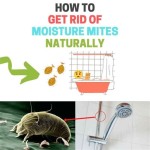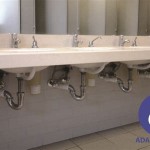How to Get Rid of Gnats Around Your Bathroom Sink
Gnats, those tiny, frustrating flies that seem to materialize out of thin air, are a common nuisance around bathroom sinks. Their presence is not only irritating but can also indicate underlying issues with plumbing, hygiene, or drainage systems. Effectively eliminating gnats requires understanding their life cycle, identifying their breeding grounds, and employing various strategies to control and prevent their return.
These tiny insects are often mistaken for fruit flies, but in the bathroom setting, they are more likely to be drain flies (also called moth flies or sewer gnats) or fungus gnats. While both are attracted to moist environments, understanding their specific characteristics can help tailor eradication methods. Drain flies, as the name suggests, thrive in the organic matter that accumulates in drains. They are small, fuzzy, and often have a moth-like appearance. Fungus gnats, on the other hand, are attracted to damp soil and decaying organic material, which can sometimes be found in houseplant pots near the bathroom.
The key to long-term gnat control lies in eliminating their breeding grounds. Ignoring this critical step will only result in a temporary reduction in their population, followed by a swift resurgence. This article will outline a comprehensive approach to identifying, treating, and preventing gnat infestations around bathroom sinks.
Identifying the Source of the Infestation
Before implementing any treatment strategies, it is crucial to pinpoint the precise source of the gnat infestation. This involves a thorough inspection of the bathroom environment, focusing on areas where moisture and organic matter accumulate. A systematic approach is necessary to avoid wasting time and resources on ineffective treatments.
Start by examining the sink drain itself. Drain flies are notorious for breeding in the slimy biofilm that lines drainpipes. This biofilm provides a constant source of food and moisture, creating an ideal environment for the flies to lay their eggs. Look for any signs of standing water in the sink basin or around the drain stopper. A slow-draining sink is a prime breeding ground.
Next, inspect the area under the sink. Check for leaks in the plumbing, especially around pipes and connections. Even small leaks can create enough moisture to attract gnats. Pay close attention to the P-trap, the curved section of pipe under the sink, as it can often trap stagnant water and organic debris. Also, look for any signs of mold or mildew growth, as these can also attract gnats.
Evaluate any potted plants in the bathroom. Fungus gnats are commonly associated with overwatered houseplants. Check the soil for signs of excessive moisture and look for small, black flies hovering around the plant. If you suspect fungus gnats, gently disturb the soil surface and observe if any flies emerge.
Beyond the immediate vicinity of the sink, inspect other potential breeding grounds in the bathroom. Check the shower drain for hair and soap scum buildup. Examine the toilet for leaks around the base or in the tank. Look for any damp areas around the floor or walls, particularly behind the toilet or under the sink. Any area with persistent moisture can harbor gnats.
Finally, consider less obvious sources of organic matter. Check the trash can for food scraps or damp tissues. Clean out any hairbrushes or combs that may contain accumulated hair and skin cells. Even small amounts of organic matter can attract gnats and provide a breeding ground.
Effective Gnat Control Methods
Once the source of the gnat infestation has been identified, it is time to implement effective control methods. A multi-pronged approach is often necessary to eliminate the problem completely and prevent its recurrence. This involves cleaning and treating potential breeding grounds, trapping adult gnats, and implementing preventive measures.
For drain flies, the primary focus should be on cleaning the drain. The most effective method is to use a drain snake or pipe brush to physically remove the biofilm from the drain walls. This is a more thorough approach than simply pouring chemicals down the drain. Follow up with a biological drain cleaner containing enzymes or bacteria that will break down organic matter. Avoid using harsh chemical drain cleaners, as they can damage pipes and are often ineffective against the biofilm. A mixture of baking soda and vinegar, followed by boiling water, can also help to dislodge and neutralize organic matter in the drain. Repeat this process several times over a few days to ensure thorough cleaning.
If fungus gnats are the problem, address the soil in your houseplants. Allow the soil to dry out completely between waterings. Consider repotting the plant with fresh, well-draining soil. You can also sprinkle a layer of diatomaceous earth (DE) on top of the soil. DE is a natural powder made from fossilized algae that dehydrates insects. Yellow sticky traps placed near the plants can also help to capture adult fungus gnats.
To address leaks and moisture issues, repair any plumbing leaks promptly. Use sealant to close any gaps around pipes or fixtures. Improve ventilation in the bathroom by opening windows or using a ventilation fan while showering. Clean up any standing water immediately and dry any damp surfaces. Consider using a dehumidifier to reduce humidity levels in the bathroom.
Trapping adult gnats can help to reduce their population while you are addressing the underlying breeding grounds. A simple gnat trap can be made by mixing apple cider vinegar, dish soap, and water in a small bowl. The vinegar attracts the gnats, and the dish soap breaks the surface tension of the water, causing them to drown. Place the trap near the sink and replace the solution as needed. Alternatively, you can purchase commercially available gnat traps.
Regular cleaning is essential for preventing future infestations. Clean the sink and drain regularly. Wipe down surfaces to remove any spills or debris. Empty the trash can frequently and keep it clean. Consider using a drain strainer to catch hair and other debris from going down the drain. Inspect the bathroom regularly for any signs of leaks or moisture problems.
Preventive Measures for Long-Term Gnat Control
Maintaining a gnat-free bathroom requires consistent effort and adherence to preventive measures. By implementing these strategies, you can minimize the risk of future infestations and enjoy a more pleasant bathroom environment. Regular maintenance and proactive attention to potential breeding grounds are key to long-term success.
One of the most important preventive measures is to maintain proper drainage in the sink and shower. Avoid allowing hair, soap scum, or other debris to accumulate in the drains. Flush the drains regularly with hot water to help prevent buildup. Consider using a drain cleaner periodically to maintain clear drainage. Be mindful of what you are putting down the drain to reduce the amount of organic matter available for gnats to feed on.
Proper ventilation is also crucial for preventing gnat infestations. Ensure that the bathroom is well-ventilated by opening windows or using a ventilation fan after showering or bathing. This will help to reduce humidity levels and prevent the growth of mold and mildew, which can attract gnats. Consider running the ventilation fan for an extended period of time after showering to ensure that the bathroom is completely dry.
Regularly inspect the bathroom for any signs of leaks or moisture problems. Check around the sink, toilet, shower, and pipes for any signs of water damage. Repair any leaks immediately to prevent the growth of mold and mildew. If you notice any damp areas, dry them thoroughly and identify the source of the moisture.
When watering houseplants in the bathroom, be careful not to overwater them. Allow the soil to dry out completely between waterings. Consider using a well-draining potting mix to prevent the soil from becoming waterlogged. Avoid allowing water to sit in the saucer beneath the pot. If you suspect fungus gnats, take steps to address the soil as described earlier.
Maintain a clean and clutter-free bathroom environment. Regularly clean the sink, toilet, shower, and floor. Empty the trash can frequently and keep it clean. Remove any clutter that may attract gnats, such as damp towels or discarded tissues. A clean bathroom is less likely to attract gnats and other pests.
Consider using natural repellents to deter gnats from entering the bathroom. Essential oils such as peppermint, eucalyptus, and citronella are known to repel insects. You can diffuse these oils in the bathroom or create a spray by mixing a few drops of essential oil with water. Spray the mixture around the sink and other areas where gnats are likely to congregate.
By consistently implementing these preventive measures, you can create an environment that is less attractive to gnats and minimize the risk of future infestations. Regular maintenance and vigilance are key to maintaining a gnat-free bathroom.

How To Get Rid Of Drain Flies Rt Olson Plumbing

The Simple Trick To Stop Pesky Gnats From Taking Over Your Drains

How To Use Home Remedies Get Rid Of Gnats Once For All

5 Easy Ways To Get Rid Of Drain Flies Fast

How To Rid Of Drain Flies Forbes Home

4 Ways To Get Rid Of Gnats In The Kitchen Wikihow

How To Get Rid Of Drain Flies
How To Get Rid Of Gnats Drain Flies Fruit And Fungus
How To Get Rid Of Gnats Drain Flies Fruit And Fungus

Fruit Flies In The Bathroom Get Rid Of Them Michael S Plumbing Orlando
Related Posts







